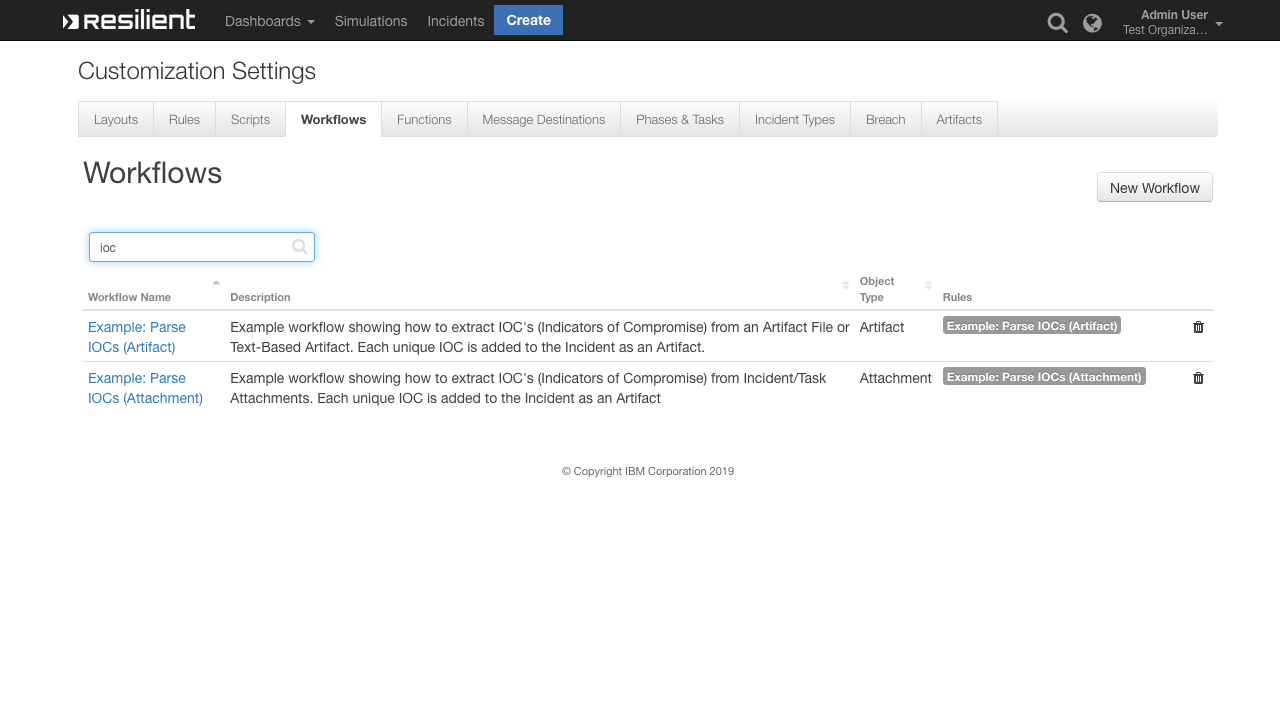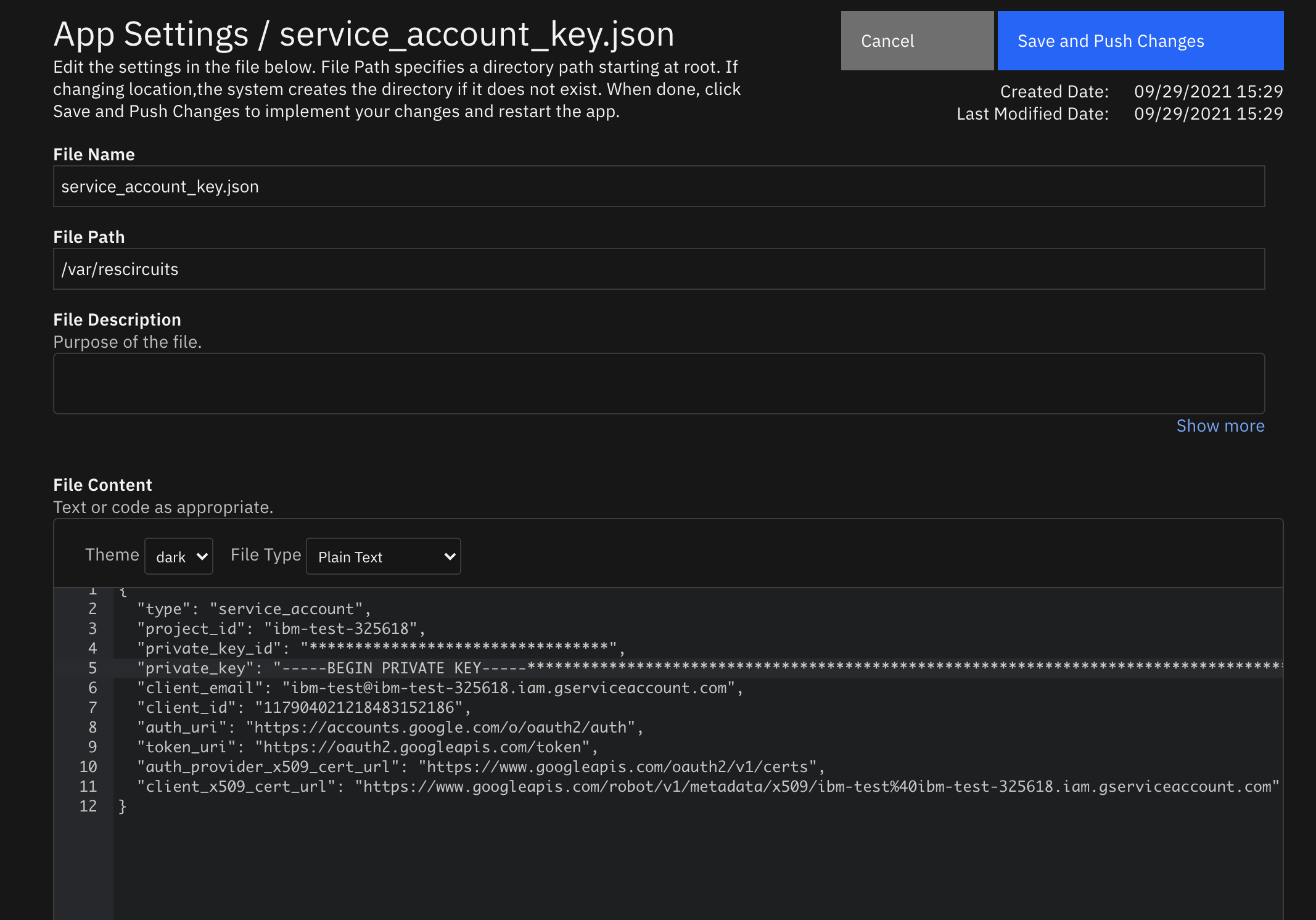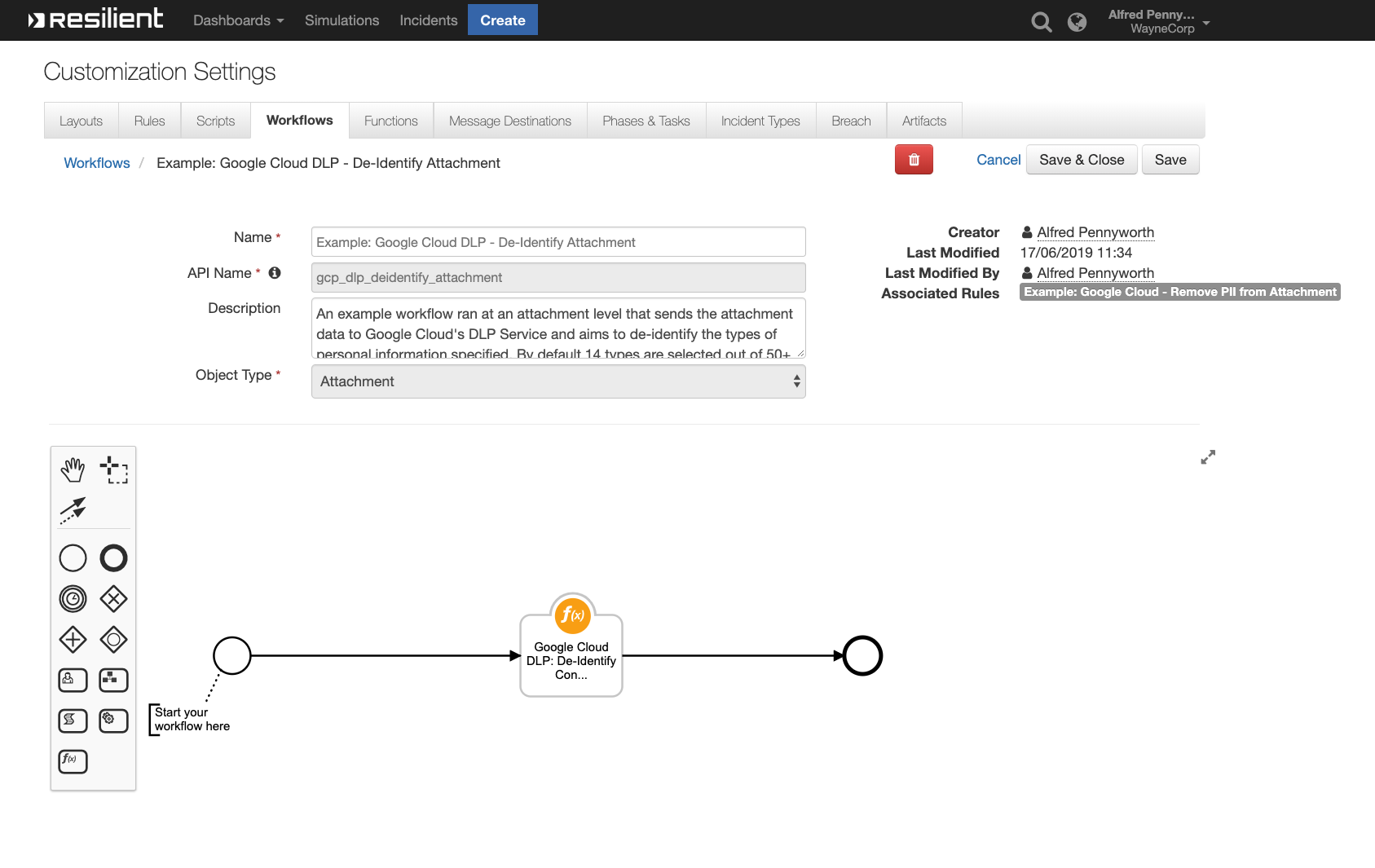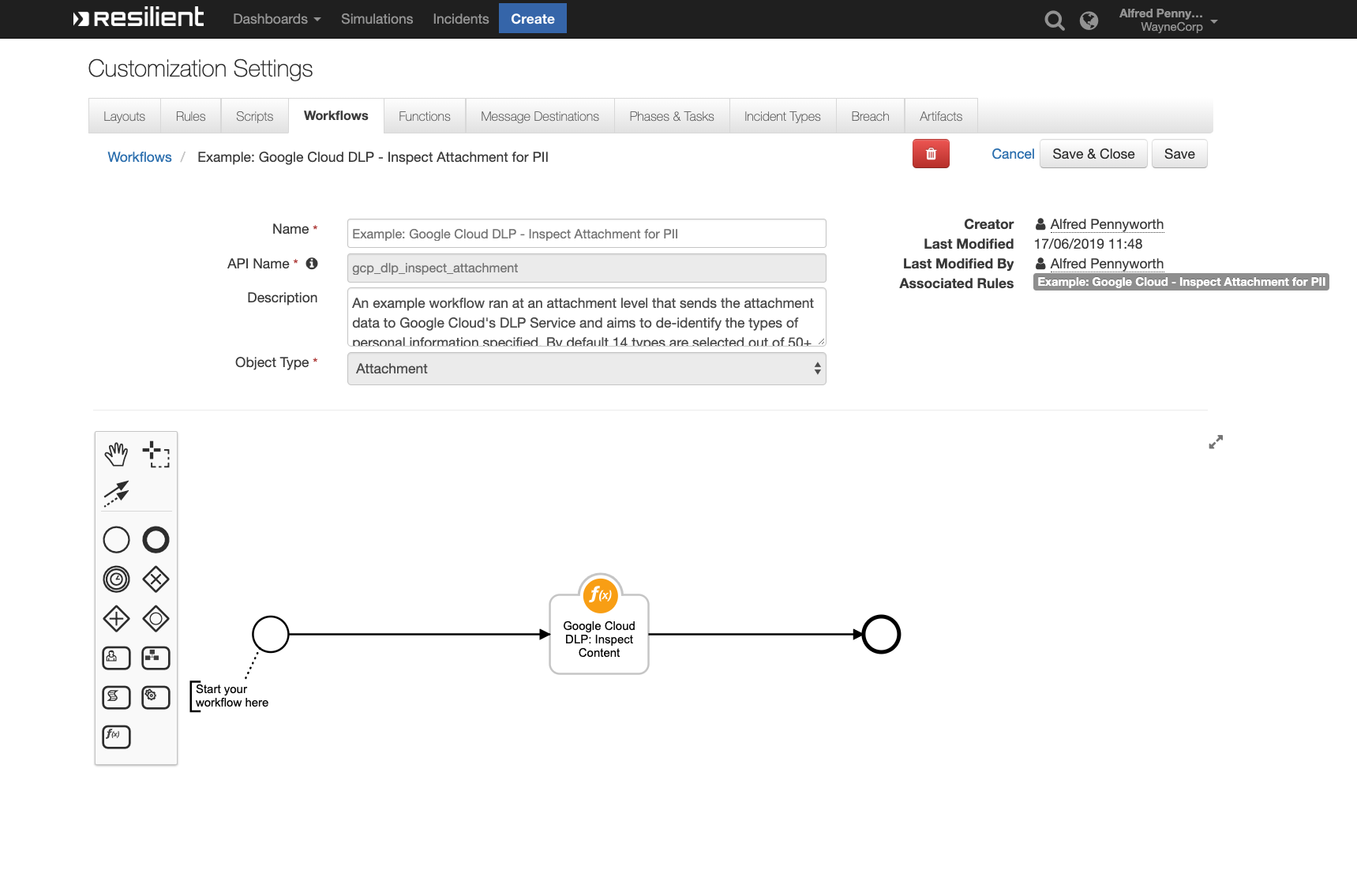Google Cloud DLP¶
Table of Contents ¶
Release Notes¶
Version |
Date |
Notes |
|---|---|---|
1.0.0 |
06/2019 |
Initial Release |
1.1.0 |
09/2021 |
Added App Host Support |
1.2.0 |
06/2022 |
Only Python 3.6 or 3.9 supported |
1.2.1 |
08/2023 |
Only Python 3.9 supported |
1.2.2 |
11/2023 |
Convert Workflow/Script to Python3 |
Overview¶
Resilient Circuits Components for ‘fn_google_cloud_dlp’

The Resilient Integration with Google Cloud DLP provides tools to integrate into your Incident Response Plan. The integration brings Automation and Orchestration capabilities for either identifying, redacting or de-identifying Personally identifiable information (PII) in a body of text.
Key Features¶
Inspect a text-based attachment for Personal Identifiable Information
Search for and redact Personal Identifiable Information from an attachment or artifact
Requirements¶
This app supports the IBM Resilient SOAR Platform and the IBM Cloud Pak for Security.
Resilient platform¶
The Resilient platform supports two app deployment mechanisms, App Host and integration server.
If deploying to a Resilient platform with an App Host, the requirements are:
Resilient platform >=
46.0.8131.The app is in a container-based format (available from the AppExchange as a
zipfile).
If deploying to a Resilient platform with an integration server, the requirements are:
Resilient platform >=
46.0.8131.The app is in the older integration format (available from the AppExchange as a
zipfile which contains atar.gzfile).Integration server is running
resilient_circuits>=46.0.0.If using an API key account, make sure the account provides the following minimum permissions:
Name
Permissions
Org Data
Read
Function
Read
The following Resilient platform guides provide additional information:
App Host Deployment Guide: provides installation, configuration, and troubleshooting information, including proxy server settings.
Integration Server Guide: provides installation, configuration, and troubleshooting information, including proxy server settings.
System Administrator Guide: provides the procedure to install, configure and deploy apps.
The above guides are available on the IBM Knowledge Center at ibm.biz/resilient-docs. On this web page, select your Resilient platform version. On the follow-on page, you can find the App Host Deployment Guide or Integration Server Guide by expanding Resilient Apps in the Table of Contents pane. The System Administrator Guide is available by expanding System Administrator.
Cloud Pak for Security¶
If you are deploying to IBM Cloud Pak for Security, the requirements are:
IBM Cloud Pak for Security >= 1.7.
Cloud Pak is configured with an App Host.
The app is in a container-based format (available from the AppExchange as a
zipfile).
The following Cloud Pak guides provide additional information:
App Host Deployment Guide: provides installation, configuration, and troubleshooting information, including proxy server settings. From the Table of Contents, select Case Management and Orchestration & Automation > Orchestration and Automation Apps.
System Administrator Guide: provides information to install, configure, and deploy apps. From the IBM Cloud Pak for Security Knowledge Center table of contents, select Case Management and Orchestration & Automation > System administrator.
These guides are available on the IBM Knowledge Center at ibm.biz/cp4s-docs. From this web page, select your IBM Cloud Pak for Security version. From the version-specific Knowledge Center page, select Case Management and Orchestration & Automation.
Authenticating to Google Cloud¶
Google Cloud requires an environment variable named GOOGLE_APPLICATION_CREDENTIALS in order to authenticate. To get the contents of this variable, you need to create a new service account with the DLP User permission in the service accounts tab. Then, under the actions column of the service accounts, select the Manage keys option and create a new key that is a JSON type.
Using an Integration Server:¶
You will need to use the export command in terminal using the path to the json file and with whatever name you’d like.
export GOOGLE_APPLICATION_CREDENTIALS="/Path/to/json/whatever_name_you_want.json"
Using App Host:¶
When configuring the app after installing, you must create a new file in the “Configuration” tab. Name the file “service_account_key.json” and have the path be “/var/rescircuits”. Paste in the contents of the json file here.

Proxy Server¶
The app does support a proxy server.
Python Environment¶
Python 3.7 or greater is supported for this app. Additional package dependencies may exist for each of these packages: *’resilient_circuits>=45.0.0’, *’google-cloud-dlp~=3.7.1’, *’PyPDF2~=2.1.0’, *’python-docx~=0.8.11’, *’defusedxml~=0.7.1’
Installation¶
Install¶
To install or uninstall an App or Integration on the Resilient platform, see the documentation at ibm.biz/resilient-docs.
To install or uninstall an App on IBM Cloud Pak for Security, see the documentation at ibm.biz/cp4s-docs and follow the instructions above to navigate to Orchestration and Automation.
App Configuration¶
The following table provides the settings you need to configure the app. These settings are made in the app.config file. See the documentation discussed in the Requirements section for the procedure.
Config |
Required |
Example |
Description |
|---|---|---|---|
gcp_project |
Yes |
|
Found in GCP |
gcp_dlp_masking_char |
Yes |
|
– |
Function - Google Cloud DLP: De-Identify Content¶
None

Inputs:
Name |
Type |
Required |
Example |
Tooltip |
|---|---|---|---|---|
|
|
No |
|
- |
|
|
No |
|
- |
|
|
No |
|
A optional input to be used when the function is ran from an artifact and is used to capture the artifacts value. |
|
|
No |
|
Which types of PII do you want to de-identify. |
|
|
Yes |
|
- |
|
|
No |
|
- |
Outputs:
{‘version’: ‘1.0’, ‘success’: True, ‘reason’: None, ‘content’: {‘de_identified_text’: ‘\ufeffSSN,gender,birthdat…##########’}, ‘raw’: ‘{“de_identified_text…########”}’, ‘inputs’: {‘gcp_dlp_info_types’: […], ‘incident_id’: 2114, ‘attachment_id’: 22}, ‘metrics’: {‘version’: ‘1.0’, ‘package’: ‘fn-google-cloud-dlp’, ‘package_version’: ‘1.2.0’, ‘host’: [hostname], ‘execution_time_ms’: 2740086, ‘timestamp’: ‘2021-09-28 17:34:07’}}
Example Pre-Process Script:
inputs.incident_id = incident.id
if artifact.type == "String":
inputs.gcp_artifact_input = artifact.value
else:
inputs.artifact_id = artifact.id
Example Post-Process Script:
"""
If the integration was successful in operation, upload a new artifact containing the now de-identified text.
"""
if results.success:
incident.addNote(u"""De-Identified using Google Cloud DLP<b>{}""".format(results.content["de_identified_text"]))
Function - Google Cloud DLP: Inspect Content¶
None

Inputs:
Name |
Type |
Required |
Example |
Tooltip |
|---|---|---|---|---|
|
|
No |
|
- |
|
|
No |
|
- |
|
|
No |
|
A optional input to be used when the function is ran from an artifact and is used to capture the artifacts value. |
|
|
No |
|
Which types of PII do you want to de-identify. |
|
|
Yes |
|
- |
|
|
No |
|
- |
Outputs:
{‘version’: ‘1.0’, ‘success’: True, ‘reason’: None, ‘content’: {‘findings’: […], ‘attachment_name’: ‘[PII Removed]sample-…ta.csv.txt’}, ‘raw’: ‘{“findings”: [], “at….csv.txt”}’, ‘inputs’: {‘gcp_dlp_info_types’: […], ‘incident_id’: 2114, ‘attachment_id’: 38}, ‘metrics’: {‘version’: ‘1.0’, ‘package’: ‘fn-google-cloud-dlp’, ‘package_version’: ‘1.2.0’, ‘host’: [hostname], ‘execution_time_ms’: 11913, ‘timestamp’: ‘2021-09-28 19:03:18’}}
Example Pre-Process Script:
inputs.incident_id = incident.id
# If this workflow has the task_id available, gather it incase we need it.
if task:
inputs.task_id = task.id
# If this workflow has the attachment_id available, gather it incase we need it.
if attachment:
inputs.attachment_id = attachment.id
# If this workflow has the artifact_id available, gather it incase we need it.
try:
if artifact:
inputs.artifact_id = artifact.id
except:
pass
Example Post-Process Script:
if results.get("success"):
"""Print all the findings as a richtext note. This note may be very long if you run the integration on a large file with lots of PII. In these cases you may want to limit how many findings are put into the note."""
if results.get("content", {}).get("findings") is not None:
attachment_name = results.get("content", {}).get("attachment_name")
note_text = """Findings were found from attachment <b>{}</b><br><br> Findings: <br>""".format(attachment_name)
for finding in results.get("content", {}).get("findings", []):
text_quote = finding.get("quote")
info_type = finding.get("info_type")
likelihood = finding.get("likelihood")
note_text += """Text Quote: <b>{}</b>
<br> Information Type Suspected: <b>{}</b>
<br> Likelihood / Confidence: <b>{}</b><br><br>""".format(text_quote, info_type, likelihood)
incident.addNote(helper.createRichText(note_text))
Rules¶
Rule Name |
Object |
Workflow Triggered |
|---|---|---|
Example: Google Cloud - Remove PII from String |
artifact |
|
Example: Google Cloud - Inspect Attachment for PII |
attachment |
|
Example: Google Cloud - Remove PII from Attachment |
attachment |
|
Troubleshooting & Support¶
Refer to the documentation listed in the Requirements section for troubleshooting information.
For Support¶
This is a IBM Community provided App. Please search the Community https://ibm.biz/resilientcommunity for assistance.